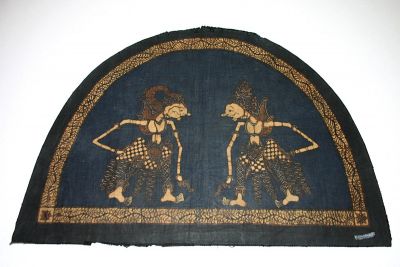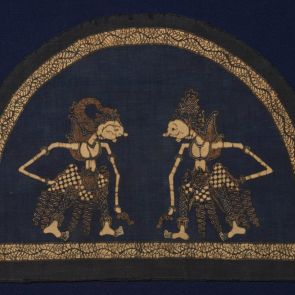
Batik textile with wayang figures
| Accession Nr.: | 51.24.1 |
|---|---|
| Type: | textile; puppetry and shadow play; textile arts |
| Date of production: |
late 19th
|
| Place of production: |
| Materials/Techniques: | batik textile |
|---|---|
| Dimensions: | height: 28 cm width: 42 cm |
Batik tablecloth with Wayang figures, from Java.
The art of batik has developed a carefully elaborated palette of forms and colours that vary from region to region, but there are also motifs reserved exclusively for monarchs. Another form of batik is created by the use of printing blocks ('cap').
Undoubtedly, Java has long been a batik stronghold. The technique consists of first sketching the desired pattern on an uncoloured canvas, then using a special tool called 'canting' to wax the areas to be left uncoloured. The fabric is then dipped into the paint where the wax layer protects the area it covers. The wax is then melted off in hot water, allowing the empty part to be coloured.
The art of batik has developed a carefully elaborated palette of forms and colours that vary from region to region, but there are also motifs reserved exclusively for monarchs. Another form of batik is created by the use of printing blocks ('cap').
Undoubtedly, Java has long been a batik stronghold. The technique consists of first sketching the desired pattern on an uncoloured canvas, then using a special tool called 'canting' to wax the areas to be left uncoloured. The fabric is then dipped into the paint where the wax layer protects the area it covers. The wax is then melted off in hot water, allowing the empty part to be coloured.
